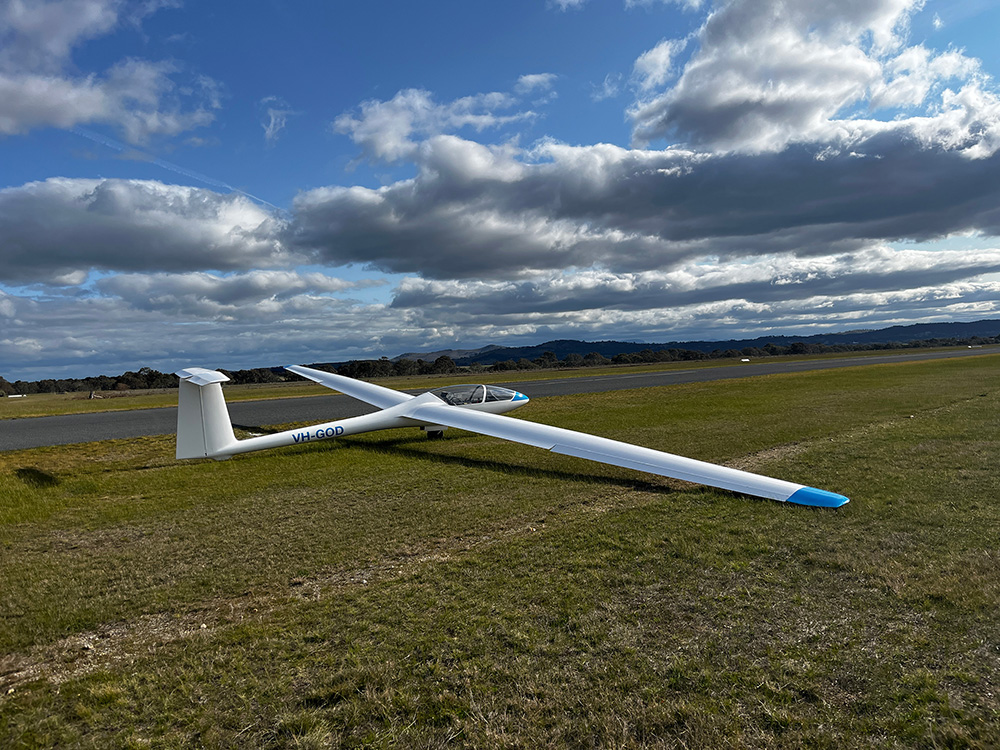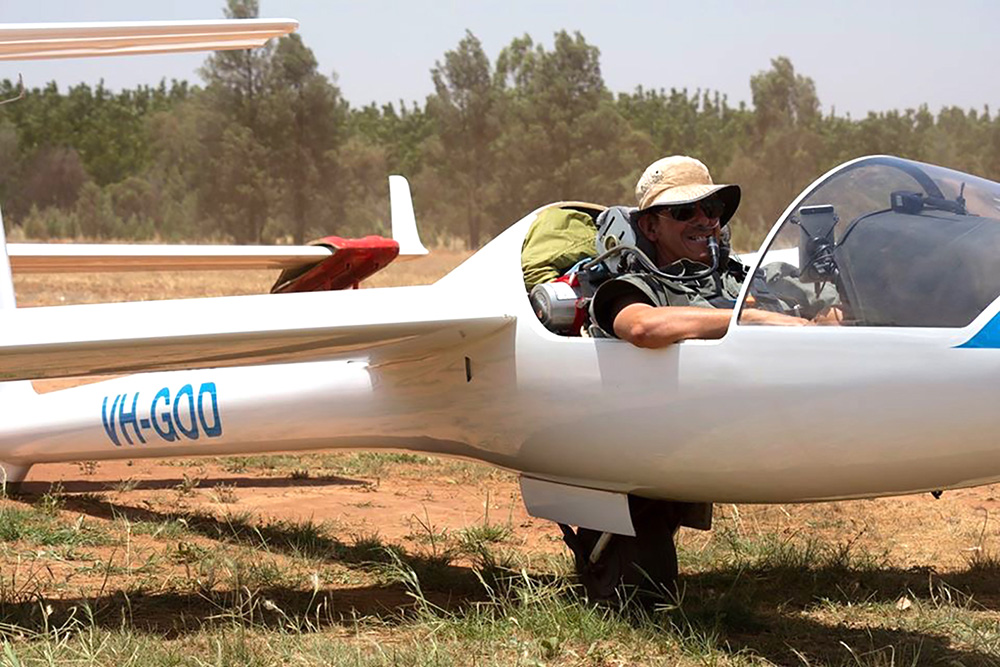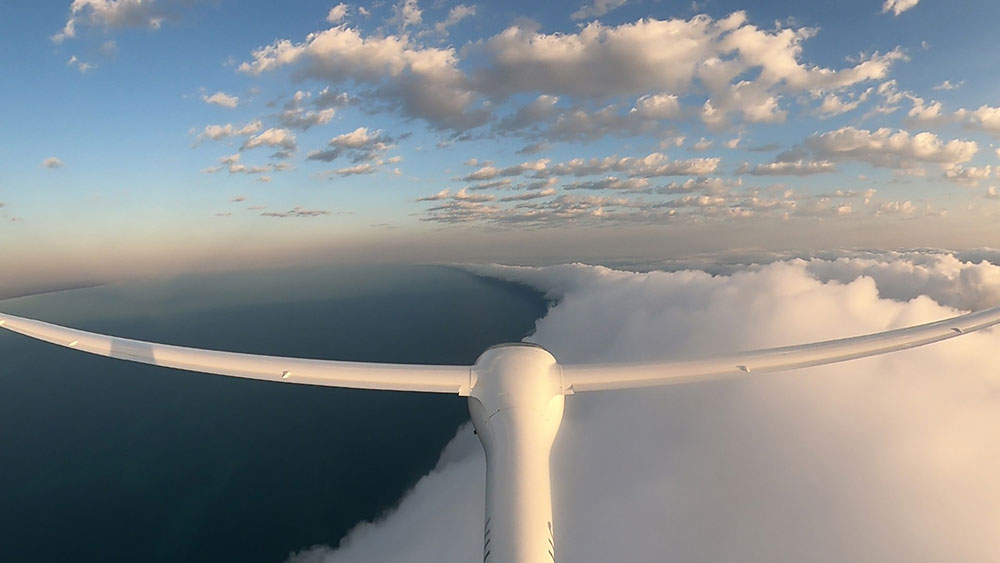
Mike in the wave over the Grampians on his way to achieving his Diamond Height.
By Mike Durrant
I have been waiting to complete my Diamond Badge for almost 40 years.
My Diamond Goal flight was on 28 December 1987 at Corowa in the Geelong Gliding Club Standard Cirrus VE. On the same flight I achieved Gold Height and my Gold C. This was quickly followed by my Diamond Distance, again in VE on 7 January 1988 at the same Christmas Camp. At that time I was only a young lad of 26!
It took me another 36 years to complete my Diamond Badge with the required height gain of 5,000m. Largely this was because I had a busy work and family life, and I prioritised competitions and long distance crosscountry flying.
Over the years, I have sporadically participated in wave camps at Lake Fyans, Pomonal, Stawell and Ararat but, in my case, the camps were more wave-less.
The challenge with wave flying is that the weather conditions are auspicious on only a few days of the year and these days are usually not aligned with your other plans and commitments.

Given my recent semi-retirement and ability to take advantage of the weather when it was suitable, I prioritised wave flying at the Grampians Soaring Club in Ararat this year to try and complete my Diamond C before the years caught up with me.
The wave camp at Grampians Soaring Club on King’s Birthday Weekend in June was an opportunity to reacquaint myself with wave flying and the best practices for safely using the wave, given the depth of experience and knowledge available at the Grampians Club.
The conditions were only mediocre with wave flying up to about 10,000ft on 11 June, but it enabled me to sort out GOD, oxygen equipment, loggers, clothing etc. I could ensure I would be ready when the wave was on - not to mention the good camaraderie and conversation around the fire in the evening and the opportunity for winch launching.
At the camp, Trevor Hancock offered me his hangar spot at Ararat to have GOD rigged on-site for the wave season. This was gratefully accepted and proved critical to being able to use the wave when it was on.
Andrzej Wroblewski had previously campaigned over a few years at Ararat to successfully achieve his Diamond Height and provided some useful advice and assistance. His main advice was that the north-westerly wave is more likely to be usable than the south-westerly airstream due to less moisture in the air and, therefore, it is easier to get into the wave. The second piece of advice was to ensure a good low point as the wave often does not go as high as you would like at the Grampians. As you will see I followed both pieces of advice, perhaps a little too enthusiastically.
A month or so after the wave camp, I drove to Ararat on a Friday night for wave that was forecast by SkySight to be very strong on the Saturday. Unfortunately, the wind on the ground was too strong for tug operations, and heavy rain showers and cloud made it impossible to launch, despite obvious wave. A small group of us hung around most of the day, hoping for an opportunity to launch but we ended up calling it off and driving home. This was south-westerly wave with a lot of moisture pulled in from the southern ocean.
Be there on the day and Take a Launch
You have to be there to play - sometimes it works, and sometimes it doesn't.
On the weekend of 3 August, SkySight started to forecast a good day on Tuesday 6 August, and via the Grampians Wave WhatsApp group I was able to arrange a launch on Tuesday at 11am when the wave was forecast to establish. The forecast was for a north-westerly with a stable layer at ridge height, with increasing winds at altitude and good weather with moderate winds at ground level. This promised good conditions for entry to the wave with wave forecast to 23,000ft plus, despite moderate wind speeds of only 30kts forecast at altitude.
As I drove to Ararat early on the morning of 6 August, the lenticular clouds were forming up over the Grampians with a strong primary wave indicated. GOD was prepped and towed out ready for launch in sunshine and relatively warm temperatures. Given the conditions I elected to stay in my jeans for the flight - which later proved to be a bad idea!
As arranged, the tug pilot arrived for an 11am launch and we started the ground roll with a tow on the runway heading for Mount William.
On tow we ran through a line of moderate rotor marked by cloud and turbulence. Just after this, the vario indicated 10kts climb so I released, hoping to get away low. As I turned to separate from the tug, the climb rate fell to zero and I realised that I was only 2,500ft above ground. I thought I was going to be chasing the tug back for another launch!
Luckily the front of the rotor was working just enough to maintain height with a great deal of care and attention. After about 20 minutes struggling in weak lift not daring to make any major change, I was able to work my way forward and contact the secondary wave just to the south of Ararat township. This wave was about 3kts and went to 13,000ft where it seemed to top out.
A very clear lenticular was sitting over the primary wave just to the east of Mount William and I headed directly for the centre of this primary lenticular.

Under a lenticular over the Grampians.
Climbing Under a Lenticular
As expected there was strong sink, up to 9kts down, heading into wind to get to the primary. The primary was contacted at 8,500ft with strong lift just to the east of Mount William. The initial climb was under the lenticular at around 3-4 kts up to 17,000ft where I had to push forward in front of the lenticular cloud to continue the climb.
The climb in front of and over the lenticular was spectacular, with fantastic views across western Victoria. I gave away the climb at 23,000ft for two major reasons. First, my legs were freezing (never go wave flying in jeans). I was now shivering in the cockpit with outside temperatures circa -30 degrees. Second, the Class A airspace in that area is FL24500 and I was not confident of my altimeter calibration to chance it any higher.
To use the height, I flew to Stawell and then back to Ararat, after descending in the down wash of the wave to get back to a warmer height as quickly as possible without using airbrakes.
At around 5,000ft I tried my airbrakes to ensure they were not frozen, and checked my undercarriage, at which point I saw that my gear had been down for the entire flight!
In retrospect I was very lucky to have the weather gods smile on me during my first real attempt to focus on my Diamond Height for the winter season. I was also lucky to be able to get away from down low after releasing prematurely. However, sometimes you make your own luck by being prepared and ready to play the game.
It was a fantastic experience and completes a task I have had on my to do list for almost 40 years.

Mike on the flight line.
Many thanks to all those that made it possible, including Rolf Buelter who was my official observer, Andrzej for sage advice and encouragement, Trevor for allowing me to use his hangar spot, Tom Clark the tug pilot who came out for one eight minute tow on the day, and all of the Grampians Soaring Club members who keep Ararat going as a wave flying site.
As a final point, while there are many sources for wave forecasts, SkySight proved very accurate and easy to use, and this greatly assisted me in being able to monitor for likely wave conditions and then exploit the wave on the day.
I strongly recommend the Grampians Soaring Club King’s Birthday Wave Camp in June as a mid-winter break and learning experience for anyone interested in wave flying!































